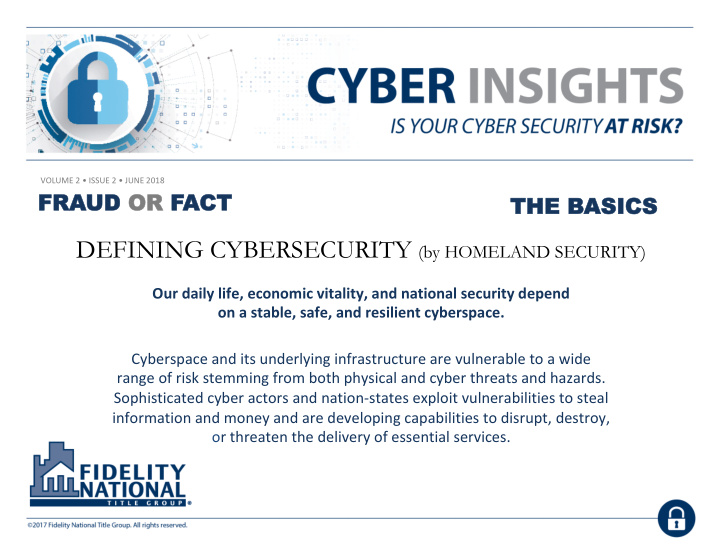



VOLUME 2 • ISSUE 2 • JUNE 2018 FR FRAUD UD OR OR FA FACT THE HE BASICS DEFINING CYBERSECURITY (by HOMELAND SECURITY) Our daily life, economic vitality, and national security depend on a stable, safe, and resilient cyberspace. Cyberspace and its underlying infrastructure are vulnerable to a wide range of risk stemming from both physical and cyber threats and hazards. Sophisticated cyber actors and nation-states exploit vulnerabilities to steal information and money and are developing capabilities to disrupt, destroy, or threaten the delivery of essential services.
FR FRAUD UD OR OR FA FACT THE HE BASICS SOCIAL ENGINEERING The use of deception to manipulate individuals into divulging confidential or personal information that may be used for fraudulent purposes. People with an online accounts, social media, or any online presence should watch for phishing attacks and other forms of social engineering. ︎ THE “ DARK WEB”
FR FRAUD UD OR OR FA FACT THE HE BASICS Types of Attacks?
FR FRAUD UD OR OR FA FACT THE HE BASICS Who may be doing the hacking?
FR FRAUD UD OR OR FA FACT Crimes imes ar are e not not onl only for or money money but but als also o for or your our da data a Terminology - NPPI & PII Defined Non-public Personal Information (“NPPI”): Personally identifiable data such as information provided by a customer on a form or application, information about a customer’s transactions, or any other information about a customer which is otherwise unavailable to the general public. NPPI includes first name or first initial and last name coupled with any of the following: Social Security Number Driver’s license number State-issued ID number Credit or debit card number Other financial account numbers NYS DFS CyberSecurity Amended Regulations: Have narrowed their broad definition of Nonpublic Information to “Business Related” information (§500.01 (g)) (earlier version covered “any information, not nonpublic or business-related information). Personally identifiable information ( PII ): Any data that could potentially identify a specific individual. Any information that can be used to distinguish one person from another and can be used for de-anonymizing anonymous data can be considered PII
Cyber ber Ins nsur urance ance Get a Get a bet better er under understanding anding • Cyber Insurance still in “wild west” territory, but improving. • Don’t purchase without reviewing current policy; consulting specialist. • Policies may become outdated quickly in light of new threats, so review regularly. • Be aware of what’s covered. Notice requirement costs? More?
Cyber ber Ins nsur urance ance Get Get a a bet better er under understanding anding FR FRAUD UD OR OR FA FACT This is why human error is so important – if someone in your office ‘clicks’ a bad link, then your agency may not have coverage for that error or cyber event that leads to hacked emails, diverted wire transfers or breach of private data.
Cyber ber Ins nsur urance ance Get Get a a bet better er under understanding anding • Ensure E&O covers defense for suits related to alleged negligent acts leading to breach or other cyber crime. • Crime coverage (also called “fidelity” insurance) and cyber policies can cover first-party losses for social engineering. • At this time, coverage for direct third party losses caused by “social engineering” scams (e.g., a client’s loss via wire fraud) may not exist.
Cyber ber Ins nsur urance ance Get Get a a bet better er under understanding anding Cyber liability provides coverage for the theft of your customers ’ non- public information NOT the theft of your customers ’ escrow funds. Cyber Liability provides coverage in the event you suffer a security breach, your customers ’ non-public information is compromised and they sue you for damages and expenses. These costs are covered under the following Cyber Liability policy insuring agreements: v Security and Privacy Liability v Privacy Regulatory Defense & Penalties v Data Recovery - Ransomware v Customer Notification and Credit Monitoring Costs v Data Extortion/Ransomware v Multimedia Liability
FRAUD FR UD OR OR FA FACT FUTUR FUT URE IMPROVEMENT NTS Help is coming in 2018 with Wi-Fi Protected Access 3 • WPA3 protocol strengthens user privacy in open networks through individualized data encryption. • WPA3 protocol will also protect against brute-force dictionary attacks, preventing hackers from making multiple login attempts by using commonly used passwords. • WPA3 protocol also offers simplified security for devices that often have no display for configuring security settings, i.e. IoT devices. • Finally, there will be a 192-bit security suite for protecting Wi-Fi users’ networks with higher security requirements, such as government, defense and industrial organizations.
VOLUME 2 • ISSUE 2 • JUNE 2018 FR FRAUD UD OR OR FA FACT PROTECT YOURSELF PROTECT YOUR BUSINESS PROTECT YOUR CUSTOMER PROTECT YOUR FUTURE STAY INFORMED
Recommend
More recommend